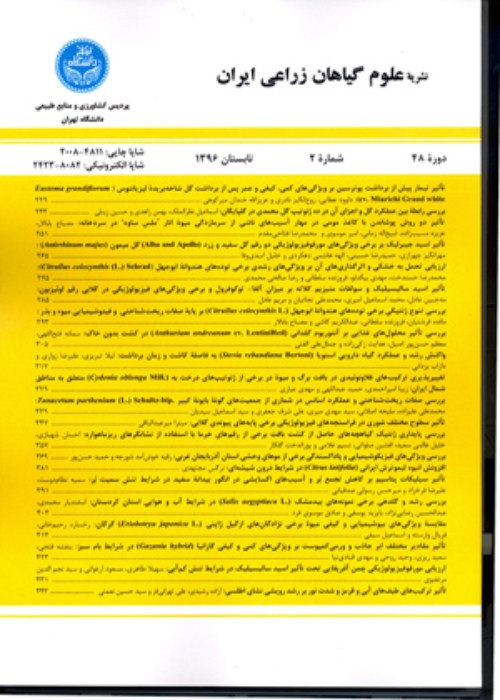Genetic Analysis of Yield and Agronomic Traits in Bread Wheat (Triticum aestivum) under Normal and Drought Stress Conditions
Author(s):
Abstract:
Drought stress is one of the most important environmental stresses that affect yield of bread wheat strongly. Considering that the yield achieved with the interaction of a large number of plant traits and environment, so the morphological and agronomical traits, can serve as selection criteria under environmental conditions. By genetic analysis and estimation of inheritance and mode of gene action of yield-related traits, we can determine effective breeding methods specifically under drought stress conditions. For this reason, 2 crosses Kavir×Shiraz and Azar2×Shiraz were performed (Shiraz is a susceptible cultivar, while Azar2 and Kavir are tolerant cultivars). F1, F2, BC1, BC2 generations obtained and along with their parents were planted in a randomized complete block design with three replications under drought stress condition. Various agronomic traits such as number of tiller, length of plant, length of main spike, length of peduncle, weight of plant, weight of main spike, weight of tiller, number of grains in main spike, 1000-grain weight, date of maturity and harvest index were measured. Results of weighted analysis of variance showed significant difference between generations for all traits. Generation mean analysis was performed. In more traits, in addition to additive and dominant effects, epistasis effects and additive× additive effects were added to the model. In traits of weight of plant, weight of stem, number of grains in main spike, and date of maturity, dominant effects was more than additive effects. Therefore, breeding of these traits is not useful and hybridization is better. For 1000-grain weight that additive effects was more than dominant effects, can use various selective methods for breeding. In traits of 1000-grain weight, number of grains in main spike, date of maturity, both of selective-based and hybrid-based methods are useful. Mean of heritabilities in stress and non-stress condition were 0.592 and 0,517. Estimation of broad, narrow sense heritabilities and mode of gene action indicated that selection for improvement of traits studied in stress condition will be suitable and traits such as length of plant and spike, weight of shoot, date of maturity, and harvest index can be used as indirect selection criteria for improving grain yield under drought stress condition. Genetic control of number of tiller, length of plant, length of peduncle and number of grains in main spike was not similar.
Keywords:
Language:
Persian
Published:
Iranian Journal of Field Crop Science, Volume:43 Issue: 1, 2012
Page:
61
magiran.com/p1017459
دانلود و مطالعه متن این مقاله با یکی از روشهای زیر امکان پذیر است:
اشتراک شخصی
با عضویت و پرداخت آنلاین حق اشتراک یکساله به مبلغ 1,390,000ريال میتوانید 70 عنوان مطلب دانلود کنید!
اشتراک سازمانی
به کتابخانه دانشگاه یا محل کار خود پیشنهاد کنید تا اشتراک سازمانی این پایگاه را برای دسترسی نامحدود همه کاربران به متن مطالب تهیه نمایند!
توجه!
- حق عضویت دریافتی صرف حمایت از نشریات عضو و نگهداری، تکمیل و توسعه مگیران میشود.
- پرداخت حق اشتراک و دانلود مقالات اجازه بازنشر آن در سایر رسانههای چاپی و دیجیتال را به کاربر نمیدهد.
In order to view content subscription is required
Personal subscription
Subscribe magiran.com for 70 € euros via PayPal and download 70 articles during a year.
Organization subscription
Please contact us to subscribe your university or library for unlimited access!



